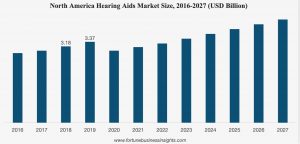The global hearing aids market size was USD8.99 billion and is projected to reach 13.38 billion by 2027, exhibiting a CAGR of 8.2% during the forecast period.
A hearing aid is an electronic device designed to amplify the sound to assist patients suffering from hearing loss or weak hearing sense. The increasing prevalence of hearing loss is set to boost the adoption of hearing devices. According to the WHO, about 466 million people worldwide lived with disabling hearing loss in 2018.
Furthermore, technological advancements, such as wirelessly connecting devices with smartphone and making them less noticeable, are expected to impact the market positively. Besides, the demand for cochlear implants is gradually increasing, especially among children. Many healthcare providers are supporting the early implantation of cochlear implants as they can restore hearing defects. This, in turn, is set to favor growth rate.
Market driving factors
-Increasing prevalence of hearing loss to boost product demand
Hearing loss has become the most common disorder in patients, especially in industrialized countries. According to WHO, the number of people living with disabling hearing loss is anticipated to reach over 900 million by 2050. Besides, chronic inflammation, vascular disorder, noise exposure, genetic susceptibility, and physiological aging of the ear may also account for the cause of hearing loss among people. This may lead to an increasing number of hearing impairment patient populations globally, thereby leading to a surge in the these devices’ sales.
– Incorporation of digital or smart technologies to drive growth
From the past decade, there has been a tremendous advancement in the field of hearing aids. The incorporation of smart technologies and the emergence of digital platforms in the mini device have helped overcome multiple patients’ difficulties and have improved their hearing experience. Features such as compatibility with smartphones, bluetooth connectivity, high sound processing, artificial intelligence, rechargeable batteries, and the latest tinnitus masking have levverages the hearing device’s potential to no bounds.
Restraining Factors
-Ignorance by patients to undergo hearing test may impede growth
Many people find it difficult to accept that they have a hearing impairment and never undergo a test. Also, due to the social stigma associated with hearing aids, many people hesitate to use them. According to the state of hearing report 2019, a global survey conducted by Cochlear ltd showed that around 92% of respondents recognize the ability to hear as an important factor for maintaining the overall quality of life. But, only 37% have had a hearing test in the last two years.
According to FDA, approximately 37.5 million adults aged between 18 years and above report having some trouble hearing without a device, ranging from ‘a little trouble’ to ‘deaf’. Furthermore, Starkey research estimated that around 42% of people who reported no hearing trouble turned to have mild hearing loss. Such considerations would reduce the number of tests conducted in hospitals, thereby narrowing the adoption of the device.

